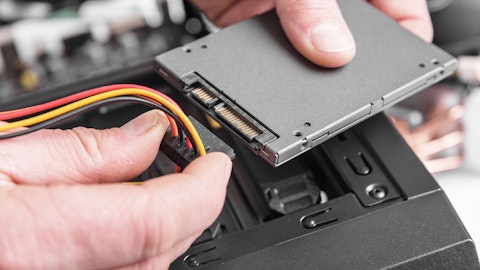Rob Dawson: Yes, I think we’d be disappointed if it wasn’t materially higher than that.
Josh Nichols: Great, thanks. I’ll hop back into queue.
Rob Dawson: Okay, thank you.
Operator: Thank you. Your next question is coming from David Wright from Henry Investment Trust. Your line is live.
David Wright: Rob, Peter, good afternoon.
Rob Dawson: Hi, David.
Peter Yin: Hi, David.
David Wright: Just can you put it — kind of quantify what large perspective order or larger products that you mentioned in the press release, give us a range of what a large — a larger order value is?
Rob Dawson: Sure. Yes, so I think that the product lines that drive that, we have our Optiflex hybrid fiber, which is — those items are, call it, $3,000 to $6,000 per unit. That’s kind of the same range that you would see with a DAC and a small cell offer as well. You’re looking at per unit, $3,000 to $6,000 or $7,000 each. It could be a little higher depending on the configuration. A large order there is something for us, order of magnitude of, call it $300,000, could be an order all the way up to $2 million or $3 million at a time. Really dependent upon how a customer decides to order. If they place a blanket order for a full year worth of deployments, you’ll see something more in the few million dollars. If they’re placing a regional and/or first quarter, second quarter, third quarter sort of placed independently, you’ll see orders that are more broken up into, call it, $200,000 to $500,000 at a clip.
David Wright: Okay. Well, thanks for putting some context there. A couple for Peter. In the non-GAAP reconciliation, you’ve got the one category that is acquisition related to another one-time charges. I noticed you had something in the fourth quarter, and the question is, do you have — are you still having any acquisition-related charges? And if so, what are they?
Peter Yin: Those are more one-time-related charges related to [Move] (ph) and [indiscernible] acquisition and related other one-time charges probably more for the 2022 timeframe and 2023 was more one-time charges related to our Move and there were some — as we went into the Move due to timing up when we took possession of the buildings, there were some accounting leases that we had to do some expensing for.
David Wright: Okay. And so you were pretty much through that now?
Peter Yin: Correct.
David Wright: Okay. And then the other question is, I notice you are into the line of credit here at your end. Can you talk about how you look at the interplay between cash on the balance sheet and use of the line? What makes those two fluctuate?
Peter Yin: Sure. Yes, this is just maintaining a certain level of cash to operate the business from a week-to-week basis. We’re always considering paying down the revolver versus keeping cash on the books to minimize the interest charge. But it’s a dynamic kind of topic that we looked at and we assessed that kind of week-to-week, month-to-month to determine if there’s anything we can use to pay that down to help save some of the interest versus keeping cash on hand and just operating the business.
David Wright: So based on kind of your outlook for the year, do you anticipate using much more of the line of credit?
Peter Yin: With current cash on hand right now, I don’t think we have any plans to draw against the revolver in the near future.
David Wright: Okay. Well, thanks for taking my questions and good luck here in your new fiscal year.
Peter Yin: Thanks, David.
Rob Dawson: Thank you.
Operator: Thank you. [Operator Instructions] Your next question is coming from [Ethan Star] (ph). Your line is live.
Unidentified Analyst: Thank you. As you work to diversify your customer base, are you primarily focused on selling existing products to new customers or developing new products to sell to both existing and new customers?
Rob Dawson: Yes, thanks, Ethan. So, a little bit of both. I think we’re probably more at this point focused on the existing portfolio of products into not just our existing customers, but expanding our customer base market-wise and also in the markets where we already play. We’ve spent a lot of time and money over the last few years redeveloping and/or relaunching the product line. So while we always have some new products coming to market, I think the expectation of our offer today is that, it’s the right offer, and we’ve got to get it in front of not just our existing customers, but additional as well.
Unidentified Analyst: Okay, if I think if I heard correctly with the introductory remarks, you said it’s about a 57% to 43% split with, I guess, 43% being roughly telecom. Do you have a goal in mind to at least further reduce your telecom dependency?
Rob Dawson: Yeah, it’s a fair question. It’s an interesting interplay between those results. I think our biggest upside from a large CapEx spend is generally the wireless or telecom marketplace. So large orders coming in will likely be in that bucket which will drive it up even more into the wireless carrier space. I think we’re going after both new market segments and we play a lot of market segments that don’t get as much notice because their CapEx isn’t as clear and as obvious in these wild upswings that we see when there’s large carrier spend. So we don’t necessarily have a specific goal. We do have goals by account and by region that we go after that are more diversified across the customer base that include all the different applications.





